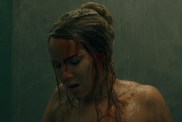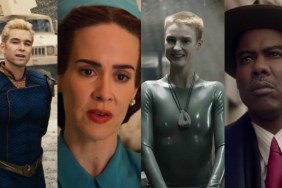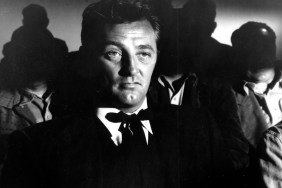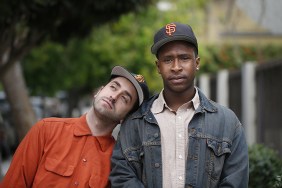
SHOCK looks at two classic films that examine the horrors of impoverished childhood and misunderstood faith.
Actor Charles Laughton’s only directorial outing was the phenomenal The Night of the Hunter (1955); a hybrid of horror and noir complete with the terrifying and terrific Robert Mitchum aping Karloff’s Frankenstein monster in one electrifying scene. The movie centers on Mitchum’s sadistic and opportunistic Reverend Harry Powell who systematically kills widows in order to take off with the menial bits of money that they have long been saving during the height of America’s Great Depression. His latest victim is the vulnerable Willa Harper (Shelley Winters) who is the mother of two precious “lambs” – the intelligent and resourceful John (Billy Chapin) and the open-hearted yet gullible Pearl (Sally Jane Bruce). The children are first introduced playing together with Pearl’s ragdoll which is seemingly the sole semblance of a plaything lying about the impoverished farm in which they live. The doll is instantly presented as damaged goods (much like the characters that populate the film) and is presented to us as a torn throwaway. John offers to fix it but is soon interrupted by his father coming home with the local police not far after him. John and Pearl’s father Bill Harper (Peter Graves) is bleeding from the shoulder and explains very quickly that he has stolen ten thousand dollars to support his family in these troubled tough times. He forces John and Pearl to swear that they will never tell about the money, and the clever John hides the wads of cash inside Pearl’s ratty doll just before the police arrive and apprehend the injured Bill. Time passes and Bill is given the death sentence rendering his wife a widow and John and Pearl fatherless. Enter Reverend Harry Powell who successfully seduces, marries, then eventually kills widow Willa, unleashing a reign of terror on the now orphaned John and Pearl who are left alone struggling to survive as well as struggling to keep the secret about the money’s hiding place.
The middle section of the movie becomes an intense battle between a demented and determined demonic stepfather and two orphan children keeping a promise buried deep inside the stuffing of a doll. John proves to be an instant adversary for Harry but Pearl is easily swayed and so innocent in her choices that she becomes the go-to child for the perverse Harry. Even when he threatens to break her arm, Pearl’s desperate need for an adult guardian is so fervent that she would risk anything to keep an elder around. But John knows better and insists they run away – crossing the river and entering new terrain. The journey made by the children into the night and upon the stillness of the large river is one of the most enchanting sequences in film history. Cinematically the scene is astounding; it is a beautiful accomplishment palpably oozing the essence of childhood innocence, fragility and need for a safe haven. Pearl’s haunting song (and ultimately her coming to realize that isolation from adults is sometimes necessary) helps aid the drifting boat as it carries the terrified babes to a new world and new life. The darkness that envelops them is sweetened by the shining hopeful lights of the glistening stars and the beasts of the woodlands (rabbits, a frog etc) help guide the little ones to safety. In this travel along the riverbank, innocence is not lost but it is transformed; with this journey into night, the children have come to understand the evils of adulthood and comprehend the notion of mistrust.

The little “lambs” in The Night of the Hunter are the keepers of secrets and the guardians of goodness; they are also creatures forced to fend for themselves and sometimes forced into acts of violence (John’s tearing down the shelf of bottled goods onto Harry’s head, jamming Harry’s in the door et al). However, these “lambs” are also potential victims of great violence. Harry’s summoning “Chilllldrrrrrun!” is chilling and truly scary; this menacing maniac hellbent on snapping the necks of these terrified youngsters in order to take off with the hidden money. When Harry realizes that the money is hidden in the doll (“It was in the doll all the time!”) it is a sight to behold – Robert Mitchum’s expression is both frightening and comical; his “Eureka in the bathtub” moment somehow makes us breathe with relief as the tension is cut and now reformed. Through this course altering plot point, the movie changes from “I know the secret but the villain doesn’t” to “Run children! Run for your lives!”
Eventually John and Pearl are bought to safety and Harry is found guilty for the murder of Willa (as well as being outed for other brutal slayings) and lynched by an angry mob – the same mob that he had once seduced with his charm and attractive presence as a gregarious and outspoken preacher. The lynching is a scene right out of a monster movie from the golden days of the Universal horror film (a beautiful linkage to Mitchum’s aping of Karloff earlier) and the remaining moments of the movie successfully express the merits and beauty of innocence, the secret sacredness of children and the importance of family. This is all beautifully captured by the magnetic performance of silent movie star Lillian Gish (now an older actress who’s maternal nature is a dominant dynamic presence) who plays Rachel Cooper a strict and stern but loving Christian woman who mothers orphans during the despondent days of the Depression. This earthy elder ultimately becomes John and Pearl’s rescuer and guidance. The movie itself opens with Rachel Cooper quoting from the bible with her babes depicted as precious angels in the heavens listening wholeheartedly, whilst in the closing moments of the film, Rachel recites a prayer for children as she works on her brood’s Christmas lunch.

Similar religious overtones are used in the British film Whistle Down The Wind (1961) in which children’s wide-eyed innocence and belief without questioning grounds the story and becomes the threat to suspicious adults. The three central rural dwelling children rescue three kittens from being drowned and nurse them back to health in a neighboring barn and right from the very beginning, these three innocents share a secret and vow to keep secrets throughout the picture. Eventually, the children become devoted to the stranger who they believe is Jesus and the mystery of Jesus – a figure who is talked about and discussed at length but who remains strange and distant gradually evolves into a realized paranoia, fragmented perception, the key to the mysteries of faith and honoring the establishment and provincial order and with the very human outcast becoming a tangible Christ for the youngsters, in an eerie and complicated way, they devote themselves to protecting him and defending him. An odd cult is formed and the film tips into the dark secluded recesses of the psychological horror film.
“We’ve got to look after him,” remarks one of the children, and on seeing their personal Jesus, the children are instantly inspired and throw themselves into a frenzy of happiness, racing through the meadowlands skipping and dancing to a whimsical childlike variant of “We Three Kings”. Bryan Forbes directs the film in stark realism, but brings the almost supernatural eeriness home with his take on the bewilderment and innocent open-hearted belief and misunderstanding faith that only children can muster. The Sunday school lessons fuel the children’s belief in their personal Christ – Kathy (Hayley Mills) asks “What would happen if Jesus came back?” which stumps the teacher who goes on to explain that Jesus has never left. But Kathy’s physical finding of her criminal-on-the-run who she believes is in fact Jesus makes more sense; she fears what would happen to him – “Would they crucify him?” “What would we do if Jesus came back to earth?” asks the teacher, and the children are taught that correct answer is “Praise him.” For Kathy and her siblings, this resonates even more.
Both The Night of the Hunter and Whistle Down The Wind depict rural impoverished living; a world of poor children making do with their imaginations and belief systems. Alan Bates as the criminal who becomes the children’s friend and messiah is an extension of a social decline and the mistakes and sins of the adult world, he represents the cult of religion and the fleeting, trembling disorder and discordant nature of wanting to be good and actually realising wholesomeness. His disciples are just as afraid of him, as they are in awe of him and when fellow countryside children all want to see Jesus, Hayley Millss Kathy makes them promise to keep him a secret from the adults “A secret from the grown ups!” Much like Elliot’s plea to his brother and sister in 1982s E.T. The Extra-Terrestrial (only little kids can see him ).
An elegant and honest dark childs fantasy, Whistle Down the Wind is more than a story about a wandering criminal hiding in a barn, it makes acute commentary on the fretful energy of God-fearing and delicate frailty of appreciating the notion of holiness. When two wide-eyed Christian children hear Alan Bates use the Lord’s name in vain, they equate his throwaway slur with a declaration of sanctity and godliness.

The film has a creepy edge to it, yet unlike The Night of the Hunter, nothing horrific or remotely violent happens (besides one of the children hitting another), however, much like the aforementioned American classic, this British sleeper truly does explore the violence of the human spirit and the restlessness of youth. Children in Whistle Down The Wind are natural believers and future cultists – there is a spookiness to these babes in the woods; their Christianity is something so embedded into their psyches that they would abide by it without flinching. Whistle Down The Wind chooses to shed light on the concept of religion for children – in this story, Christianity is something that lives within the mutterings of adults and a complete mystery to the likes of innocent creatures who have only spent a few years on the earth, as opposed to films like Children of the Corn (1984) where it is a twisted selfish religion in service of a bloodthirsty god.
Children hide the murderer in Forbess film and the cult of children demanding their “Jesus” to tell them stories is much like forced performance. When the Christ-criminal snaps, it startles the children and he realizes this, then takes up a magazine and reads an article to them. He understands that these children, his newfound cult of devoted believers, are a powerful ally. The inner turmoil, angst and violence of the human condition is somewhat tranquilized by the tenderness of innocence and purity of belief.
“Why are you helping me?” asks the criminal, “Because we love you” replies the head of the cult. When she gives him a religious picture depicting Jesus with his brethren, the criminal takes it all in and makes sense of it all, and he uses this innocent and pure belief to his advantage. But in this choice, he gives the children something to believe in.
The children grow aggressive among each other – they all want a piece of “Jesus” and one boy slaps the ringleader across the face (the direct tangible violence of the piece). Both Laughtons picture and the British counterpart are heightened realities of children under attack, forced to believe, on the run, keeping secrets and lead into dangerous territories and this majestic power of narrative persuasive intellect is what propels these two films into a dark terrain and the monstrous decadence of the coming-of-age child-centric horror film.









